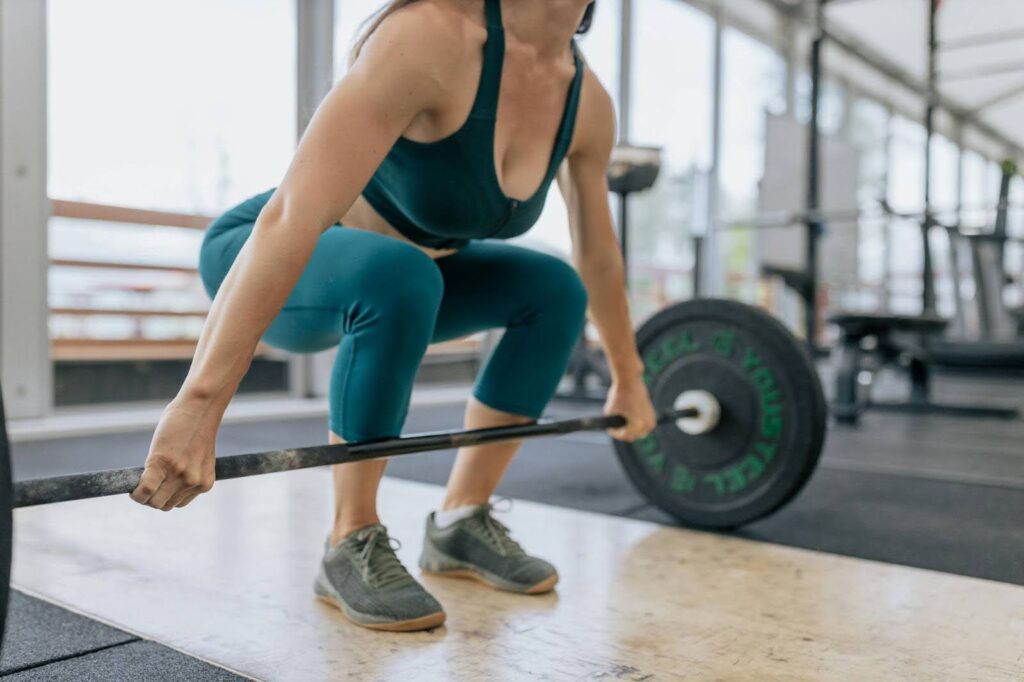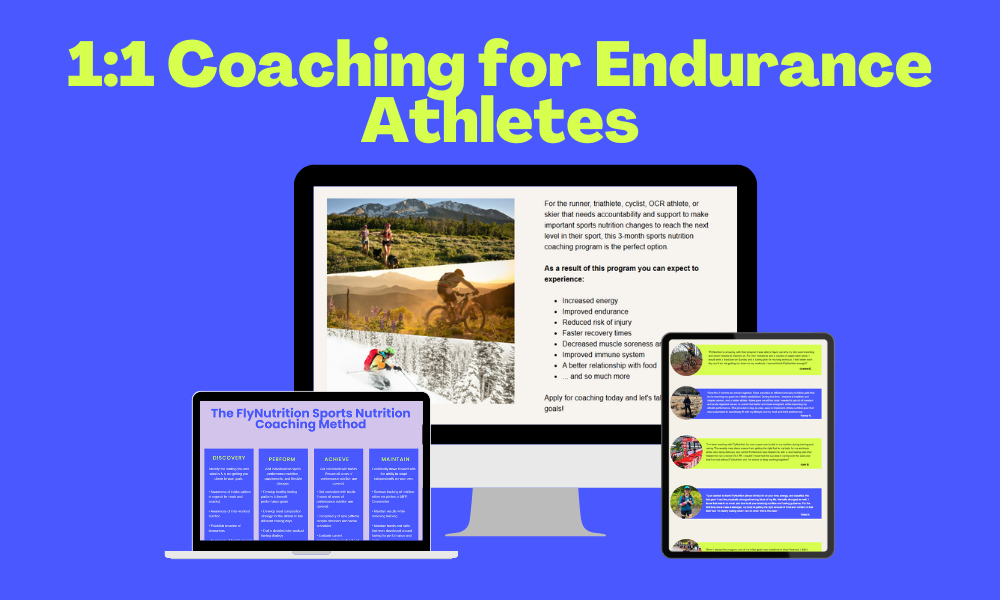Are you a female athlete who feels like you’re constantly tired, not recovering well, or stuck at a performance plateau—despite doing everything “right”? You’re not the only one.
Female endurance athletes face a unique set of challenges when it comes to training and nutrition. And while the intentions are good—pushing hard, eating “clean,” staying lean—the results often lead to fatigue, hormonal disruption, injuries, and underperformance.
As a sports dietitian working with female athletes, I’ve seen the same mistakes repeated over and over. The good news? Once you recognize these patterns, you can fix them—and the changes in performance and well-being can be dramatic.
In this blog post, we’ll break down six of the most common mistakes female athletes make, particularly those in endurance sports. You’ll learn why these habits are problematic and what to do instead, using a compassionate and science-backed approach. Let’s dive in!

Mistake #1: Underfueling as a Female Athlete
Many female athletes struggle with eating enough to support their training—not because they don’t care, but because they’ve absorbed conflicting messages about nutrition, performance, and body image.
Whether it’s intentional or unintentional, not eating enough to support your training is one of the most damaging mistakes a female athlete can make.
Underfueling leads to low energy availability (LEA), which means your body doesn’t have enough energy left over for basic functions after exercise. This can result in a condition called Relative Energy Deficiency in Sport (RED-S), which affects hormone levels, bone health, metabolism, and mental focus.
To top it off, underfueling can be sneaky. Maybe you’re skipping breakfast, training fasted, or simply not eating enough carbs and fat. Even high-quality, nutrient-dense meals might fall short if you’re training hard and not eating enough volume.
Signs of Underfueling:
These red flags are common among endurance athletes and are your body’s way of signaling it’s not getting enough fuel:
- Chronic fatigue
- Missed or irregular periods
- Frequent illnesses or injuries
- Poor workout recovery
- Mood swings or irritability
Fix it: If you’re experiencing these symptoms, here are some first steps to correct your energy intake:
- Eat within an hour of waking up, especially if you train in the morning.
- Include carbohydrates in every meal and snack.
- Track your energy levels and recovery—if they’re consistently poor, underfueling might be the cause.
Mistake #2: Cutting Out Carbohydrates
Low-carb diets may be popular, but they’re often incompatible with the demands of endurance sports. It’s trendy in wellness circles to cut carbs—but for the female endurance athlete, this is a recipe for burnout.
Here’s why reducing or avoiding carbs can be especially harmful for female athletes.
Carbohydrates are your body’s most efficient energy source during endurance activities. Restricting them leads to poor glycogen storage, fatigue, hormone disruption, and increased risk of RED-S.
Why Carbs Matter for Female Athletes
Here’s how carbs directly support endurance performance and overall well-being:
- They fuel high-intensity and long-duration training sessions.
- They help regulate cortisol and reduce training stress.
- They support healthy menstrual cycles.
- They speed up recovery and muscle repair.
Avoiding carbs in the name of “clean eating” or body composition goals is a common pitfall—and one that often backfires. You might feel sluggish, have difficulty hitting splits, or start to dread training.
Fix it: Start by integrating more accessible sources of carbohydrates around your training:
- Don’t fear white rice, bread, pasta, or sports gels—these are performance fuels.
- Time your carb intake around training (before, during, and after).
- Think of carbs as fuel, not a reward.
Mistake #3: Skipping Recovery Nutrition
Recovery isn’t just about rest—it’s about what you put on your plate, too. Post-workout nutrition is often overlooked, but it’s one of the fastest ways to support performance, reduce fatigue, and prevent injury.
If you’re not refueling properly afterward, you’re leaving gains on the table.
Post-workout recovery nutrition is critical, especially for endurance athletes training multiple times a week. Skipping or delaying recovery meals leads to prolonged muscle soreness, poor adaptations, and compromised immune function.
Why Recovery Nutrition Is Important
These benefits show just how important it is to eat after a hard session:
- It replenishes glycogen stores depleted during training.
- It supports muscle repair with adequate protein.
- It reduces cortisol and jumpstarts the recovery process.
- It helps regulate appetite throughout the day.
Many female athletes, especially those with busy schedules, unintentionally skip this step—or opt for low-carb, low-protein options that don’t meet recovery needs.
Fix it: To get the most from your recovery window, try these easy fueling strategies:
- Aim for a recovery meal or snack within 30–60 minutes of training.
- Include both carbs and protein—think Greek yogurt and fruit, chocolate milk, or a sandwich with lean protein.
- Don’t rely on appetite alone; sometimes it’s suppressed post-exercise.

Mistake #4: Not Utilizing Strength Training
There’s a myth that endurance athletes don’t need to lift weights—that it’ll bulk you up or interfere with cardio gains. But research tells a different story. Endurance sports like running, cycling, and triathlon require stamina—but they also demand strength.
Strength training is essential for female athletes. It improves running economy, supports bone health, boosts power, and reduces injury risk.
Why Female Athletes Need Strength Training
Here’s how strength work benefits endurance athletes long-term:
- Builds neuromuscular coordination for more efficient movement.
- Helps maintain lean mass, especially during high mileage.
- Supports bone density and reduces osteoporosis risk.
- Aids in hormonal regulation through increased muscle mass.
Endurance athletes often skip strength work in favor of more mileage—but this can lead to overuse injuries, plateaus, and muscle imbalances.
Fix it: Incorporating strength doesn’t have to be complicated—just consistent:
- Include strength training 2x per week.
- Focus on compound lifts (squats, deadlifts, rows) with good form.
- Don’t be afraid to lift heavy—strength is your friend, not your enemy.
Mistake #5: Ignoring Training Fatigue
Fatigue is a normal part of training—but when it sticks around too long, it becomes a red flag.
There’s a difference between pushing through a tough workout and ignoring your body’s cry for rest. Too often, female athletes mistake fatigue for weakness—and keep grinding.
Training fatigue is a natural part of the process—but when it becomes chronic, it signals a deeper issue: under-recovery.
Symptoms of Chronic Training Fatigue
Here are some warning signs that you may be experiencing training fatigue:
- Resting heart rate increases
- Decreased motivation or enjoyment
- Declining performance despite consistent effort
- Sleep disruptions or mood swings
Many female athletes push through these symptoms, fearing they’ll lose progress if they rest. But the opposite is true—recovery is where gains are made.
Fix it: When fatigue lingers, these habits can help you bounce back faster:
- Monitor your training load and rest days.
- Periodize your training with recovery weeks.
- Sleep 7–9 hours a night and prioritize nutrition.
- Listen to your internal cues—not just your training plan.
Mistake #6: Overtraining
Overtraining isn’t just about doing too much—it’s about doing too much without enough recovery. Female athletes are particularly vulnerable due to hormonal considerations, lifestyle stressors, and the pressure to constantly perform.
Overtraining syndrome (OTS) is real—and it’s often missed in female athletes because it’s masked as discipline or mental toughness.
While pushing limits is part of being an athlete, consistent overreaching without adequate recovery leads to hormonal disruptions, injury, and even mental health struggles.
Female Overtraining Symptoms
Pay close attention to these physiological and emotional shifts:
- Loss of menstrual cycle (amenorrhea)
- Constant fatigue that doesn’t resolve with rest
- Irritability, depression, or anxiety
- Stalled or declining performance
- Frequent illness or nagging injuries
Overtraining is often tied to the “more is better” mindset, which is amplified by comparison culture and social media. But everybody has a threshold—and ignoring yours can do long-term damage.
Fix it: Recovery from overtraining requires intentional changes—not just a few easy days:
- Recognize that rest is a performance tool, not a weakness.
- Work with a coach or dietitian to monitor total load.
- Prioritize consistency over intensity.
- Learn to distinguish between hard work and overwork.

FAQs: Answers to Common Questions Female Athletes Ask
If you’re just starting to question your nutrition or recovery habits—or you’re deep in the endurance world and wondering why things feel off—these common questions can help guide your next steps.
What are signs of overtraining in female athletes?
Common signs include persistent fatigue, missed periods, mood changes, declining performance, and frequent illness or injury. If rest doesn’t help, it may be overtraining.
Why do endurance athletes need carbohydrates?
Carbs are the body’s preferred fuel source during long or intense sessions. They help replenish glycogen stores, reduce fatigue, and support hormonal health.
How soon should I eat after a run?
Aim to eat within 30–60 minutes of finishing a workout. A mix of carbs and protein helps speed up recovery, replenish energy, and reduce muscle soreness.
Can clean eating be harmful for athletes?
Yes—overly rigid “clean eating” can lead to underfueling and GI issues during training. Athletes need a flexible approach that includes performance-focused foods.
Is strength training necessary for female endurance athletes?
Absolutely. Strength work improves performance, reduces injury risk, and supports hormonal and bone health—especially important for female athletes.
What Every Female Athlete Should Know
If you’re a female athlete, your body has unique needs—and honoring those needs is essential for long-term success in endurance sports.
Whether you’re cutting carbs, skipping recovery, or pushing through fatigue, these common mistakes don’t make you weak—they make you human. And once you’re aware of them, you can course-correct with confidence.
Fuel well. Train smart. And remember: performance is about more than just willpower—it’s about giving your body what it truly needs.
Need help making these changes? If you’re ready to stop guessing and start fueling with purpose, I offer 1:1 coaching tailored to female endurance athletes.
Apply for coaching here and let’s work together to build a plan that supports your body, training, and goals.

Be The First To Comment